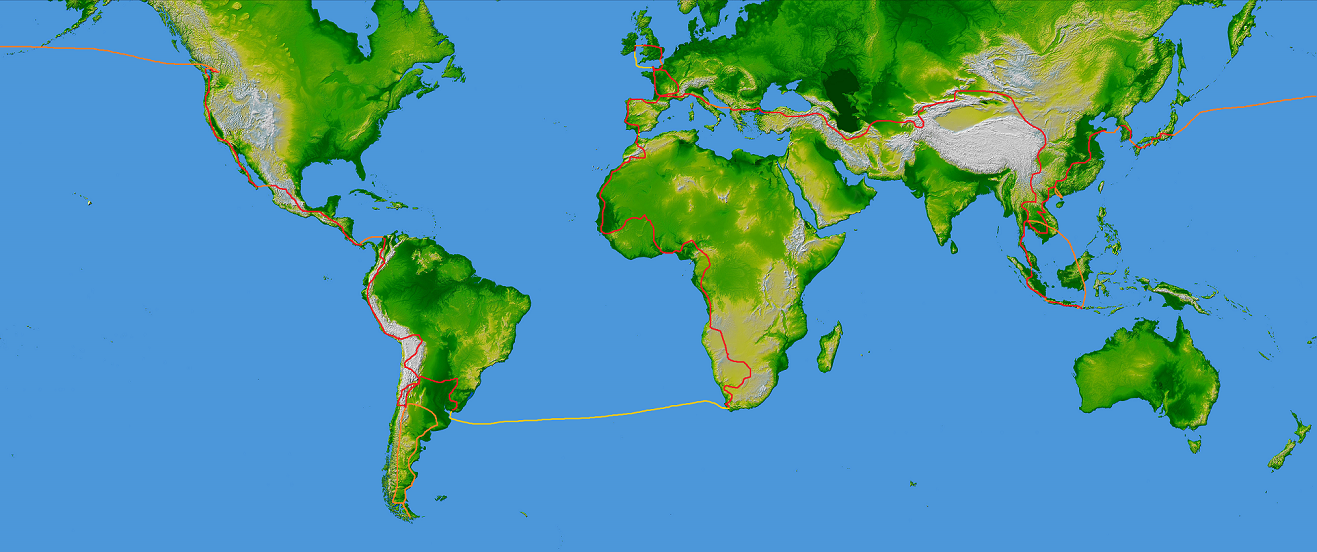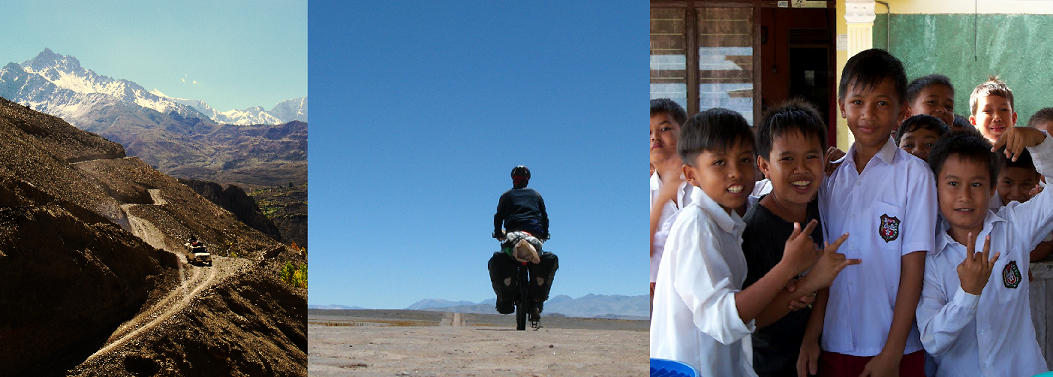Day three hundred and sixty-five started a little earlier than most, the southern hemisphere's chilly winter morning rousing me to a state of frigid consciousness at 4 am. An hour later I decided that a warm shower and hot bowl of porridge was preferable to slowly succumbing to frostbite in my lightweight (i.e. useless) sleeping bag. For the past couple of weeks I have been warding off the early morning chill with the remarkably effective solution of sleeping inside an empty 50 kilogram maize sack. As the nights continue to cool down, however, with a corresponding increase in my latitude reading I may have to get more sacks.
On my way south to Namibia's capital, Windhoek, I spent a couple of nights at the Kai-Oms (Our House) hostel in Outjo, a small town that lies south of Etosha national park. Peter wanted to make a detour, a 500 km detour to be exact, to visit Swakopmund on the coast. Having visited the town on a previous trip to Namibia in 2001, I decided to forego the pleasure of an extra few days in the saddle and reunite with Peter in Windhoek for the final stage together in the Tour d'Afrique, along the trans-Kalahari highway in Botswana to South Africa. Our last few days in Angola had been somewhat challenging with a bout of malaria for Peter and then, following some bad advice, we found ourselves pushing our bikes along a sandy track that led south from Cahama to the border town of Calueque. The moral of the latter being: never listen to someone driving a Landcruiser about which roads are passable on a bicycle.
We crossed into Namibia on 17th July and with tar on the roads (well the main ones at any rate) and food in the shops, a love affair with Namibia was all but guaranteed. Following two days off in the northern hamlet of Ruacana, most of the time being spent marveling at and eating the food for sale in the BP service station, we rode south to Kamanjab. As we skirted the western boundary of Etosha park, we were warned by a concerned policeman that lions "operated" in the area and that they might well take a fancy to two passing cyclists. In the end we only spotted varieties of antelope, zebra and giraffe - fantastic to cycle past nonetheless. On arrival in Kamanjab we learned that our proposed route south to Swakopmund would be hampered by sand and I lost no time in deciding that the tarred route to Otjiwarongo and on to Windhoek was the road for me. Namibia is undoubtedly endowed with many magnificent and awe-inspiring landscapes and natural features but unfortunately many are not accessible to bicycles, at least loaded ones, and especially so if you have developed a deep-seated aversion to fine particles of sand.
And so it was that I found myself alone in Outjo, taking a first time trial separation from Peter since our several months traveling together. By mid-afternoon Day 365 I was being first cajoled and then harangued into declaring where my loyalty lay in the pending Tri-Nations rugby match between New Zealand's All Blacks and South Africa's Springboks. In between shots of Jagermeister and bottles of cold Tafel lager I surveyed the small sports club bar that I had come to with Deon, the very hospitable and friendly owner of the hostel where I was camped up. The handful of customers in the bar were all Afrikaaners from either Namibia or South Africa. Many from the latter appearing to have emigrated north in recent years to escape the rat race and crime epidemic of South Africa's cities. The roof of the bar was adorned with large flags of the famous rugby clubs in the region. Amidst the collage hung two old South African flags from pre-1994 and along with the rescued street sign of 'Voortrekker Str' that hung above the whisky and brandy bottles, it wasn't hard to imagine which direction many of the patron's political sympathies lay.
Fortunately, a lot of the little I do know about rugby was gleaned from John Carlin's (2008) recent book, Playing The Enemy, which focuses on the political build-up to the rugby world cup that was held in South Africa in 1995. In the final match, against the odds, the host nation beat the All Blacks as they were cheered on by the recently elected president of South Africa, Nelson Mandela, who was famously repleat in the No.6 Springbok jersey. Carlin's aim in the book was to demonstrate Mandela's inspirational ability to see the bigger picture and to break down the barriers of fear of the new regime that many of the white South African's felt. As the favourite past time of white (male?) South Africa, Mandela recognised the role that rugby could play in uniting his fractured nation. By embracing the world cup and genuinely supporting the Springbok team, Mandela was supporting what most of the black population in South Africa undeniably viewed as symbols of the oppressive and brutal apartheid regime.
Prior to 1994, rugby had been very cleverly used by the anti-apartheid movement to bring international attention to their cause by ensuring that boycotts were placed on the Springbok's ability to compete internationally. As a result of the boycotts, the Springboks were unable to play in the first two rugby world cups in 1987 and 1991. And yet here was their beloved president embracing the game and even wearing the captain's jersey. What Mandela magnanimously realised was that it was only through such gestures of acceptance and solidarity that he could begin to unite the nation's divided racial factions and assure white South African's that they need not fear retribution from the ANC government. When the Springboks won the world cup in 1995, celebrations were memorably and unprecedentedly held across all of the various communities in South Africa and the episode is fondly remembered as both a great sporting result and a political masterpiece in conflict resolution by Mandela.
Windhoek, Namibia
Trip distance: 19,346 km








